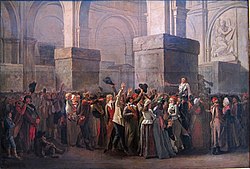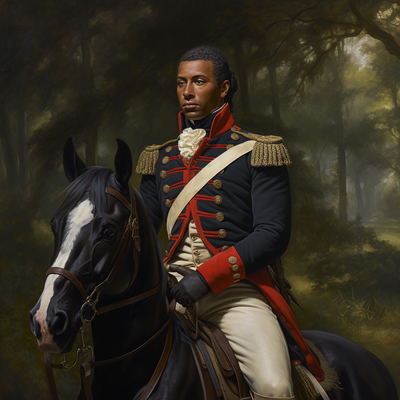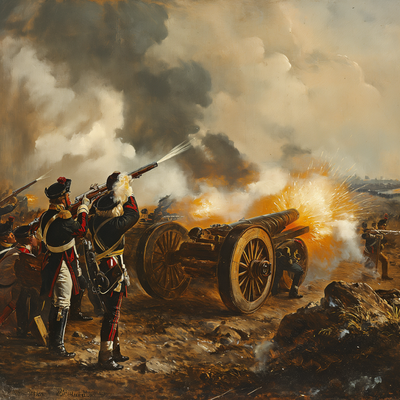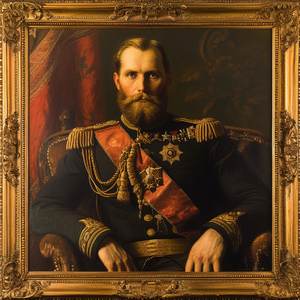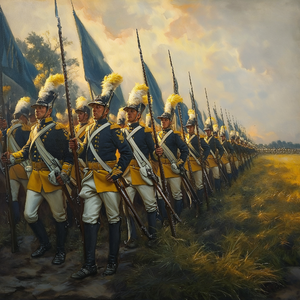Seran War of Unification
This article is incomplete because it is pending further input from participants, or it is a work-in-progress by one author. Please comment on this article's talk page to share your input, comments and questions. Note: To contribute to this article, you may need to seek help from the author(s) of this page. |
| Seran War of Unification | |||||||
|---|---|---|---|---|---|---|---|
 Royal Monarchists engage with Coalition Forces during the winter of 1737 in the city of Corinth. | |||||||
| |||||||
| Belligerents | |||||||
|
Royal Monarchists |
Revolutionary Coalition | ||||||
| Commanders and leaders | |||||||
|
| ||||||
| Strength | |||||||
|
| ||||||
| Casualties and losses | |||||||
|
| ||||||
| Total:118,500 - 153,500+ | |||||||
The Seran War of Unification, also known as the Unity War, was a pivotal conflict in the history of the United States of Sera, marked by the relentless struggle for power and supremacy among the Seran aristocracy. The war unfolded under the leadership of Lord-General Kwame Tu'Aruc and Carlotta Tu'Aruc[1], revered Seran nobles and the inaugural monarchs of the unified nation. The roots of the conflict lay in the aftermath of the demise of the Quadrumvirate, the ruling council comprising leaders of the Kingdom of Koga, the Sakhile Principality, the United Mbaku Tribes, and the Latinius Kingdom. The heads of each region comprised the four ruling members of the loose confederation that made up the Confederacy of Seran Tribes. Sometime in the 1710s, the council ruled that after the death of the members that comprised the council, the country would become unified under a single, powerful ruler and would exist as a autocratic absolute monarchy. To this end, the rulers of the Mbaku and Sakhile selected a man and woman from the Koga and Latinius to become the autocratic rulers of the unified country.
Background
Following their deaths, discontent among the sons and daughters of the kings and chiefs who were excluded from power and inheritance led to the formation of a coalition to resist unification. It was their goal and utmost desire to keep the status quo so that they themselves would not lose out on their opportunity to rule. Among those vying for power was then-Prince Kofi Ofori of the Sakhile, Princess Nia Mbaso, Duke Grant Kane, and Duchess Mara Olomule, as well as several members of the aristocracy from all four of the Seran member states. This alliance sought to resist the ascendancy of the newly crowned monarchs, Kwame Tu'Aruc and his queen, who sought to unite the disparate Seran territories.[2]
To this end, the Revolutionary Council as they would come to be called penned a letter of dissent to the would-be monarchy and vowed their unwavering resistance to any attempts to exert authority over their respective regions. In the event of war, the council tapped former Latinius general Percy A. Hightower and Sakhile aristocrat Robert A. Kraft to lead the coalition to war against the monarchs should the need arise.[3] In response to the letter, the King responded by ordering the immediate dissolution of the council. When the council ultimately refused, King and Queen Tu'Aruc labeled the members of the coalition as traitors and began to raise an army to arrest them. The coalition's rebellion manifested as a sizable and diverse force, each faction driven by the desire to preserve its regional influence. Their united front created a formidable opposition that forced Kwame Tu'Aruc to confront not only external threats but also internal dissent within the Seran aristocracy[4]. The war that ensued was marked not only by the scale of the conflict but also by the ruthless strategies employed by the coalition to maintain their grip on power.
As Kwame Tu'Aruc faced challenges in securing the loyalty of his own forces, the coalition's rebellion intensified, plunging the Seran territories into a state of chaos and uncertainty. The struggle for supremacy unfolded across the several regions and territories of the fledgling Seran nation, each region becoming a battleground for conflicting visions of governance and authority.
| This article is part of a series on the |
| History of the United States of Sera |
|---|
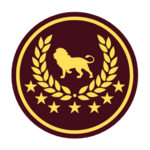 |
The turning point in the war came with the pivotal Battle of Veridian Fields in January of 1741. It was a decisive engagement that saw Lord-General Kwame Tu'Aruc's forces clashing with the sizable, battle hardned, and veteran forces of Percy Hightower. It would be the last time the two veritable giants of the war would clash. The battle would see the greatest violence in the war and would be unmatched in both scale and death toll until the Seran Secessionist War two centuries later. Lord-General Tu'Aruc was able to encircle and destroy most of the Revolutionary Army, and with the formal surrender of General Hightower at Concordia Square in Alexandria, the war concluded with Royal Monarchist victory. After overcoming the coalition's resistance, solidifying his authority and unifying the Seran nation under his rulership. The battle not only marked the end of the war but also established Kwame Tu'Aruc as the first and only Lord-General in Seran history[5].
The members of the Revolutionary Council were placed on trial in the newly established High Tribunal, and either faced execution or forced labor sentences. For his role, General Hightower was stripped of his land and titles, however would later be hired as a military attaché and later an instructor at the prestigious Kado Military Academy.
Prelude to War
At the heart of the prelude to war lies the unraveling of the Quadrumvirate, the once-unifying ruling council comprising leaders from diverse Seran regions. The demise of this governing body left a power vacuum that proved to be a breeding ground for discontent among the sons and daughters of kings and chiefs, who found themselves excluded from the corridors of influence. The ensuing political turbulence set the stage for the formation of the Revolutionary Council, a faction driven by a fervent desire for self-determination and stringent decentralization to preserve the status quo of their own positions.
As whispers of dissent permeated the aristocracy, Prince Kofi Ofori - himself the son of the recently deceased Chief of the United Mbaku Tribes - started to sow even more discontent amongst his peers as early as 1727[6]. As time went on and more members of the aging ruling council died, the aristocracy started to take the threat of autocratic rule and the loss of their generational authority impending. Soon, Kofi found himself with no lack of allies pledging themselves, their wealth, manpower, expertise, and material to resist a total unification under a single banner. In secret, 27 nobles, aristocrats, wealthy business owners, and royalty met in Alexandria, Carthage to discuss danger posed by the "would-be" King and Queen of the Seran people. It was during these talks that he emerged as a prominent figure rallying the disenchanted factions. Ofori's skillful navigation of regional loyalties and grievances resulted in the formation of a formidable coalition, united under a common banner against the perceived centralization of power represented by the impending monarchy.
It was during these meetings that the Coalition selected two men who would act as heads of the Revolutionary Guard. General Percy A. Hightower, a staunchly loyal Latinius military commander who was coerced into leading by the Queen-Consort of the Latinius King, and Robert A. Kraft, a decorated war veteran who volunteered willingly as a member of the Sakhile aristocracy.[7] General Hightower's unwavering commitment and military prowess, coupled with Kraft's experience and dedication, solidified the Revolutionary Guard as a formidable force ready to counter the perceived threat posed by the would-be Seran monarchy.
As tensions between the Revolutionary Council and the monarchy escalated, the conflict took a decisive turn when the council penned a letter of dissent to King and Queen Tu'Aruc. In the letter, the council members expressed their vehement opposition to any attempts to exert authority over their respective regions and vowed unwavering resistance against what they perceived as a threat to their established positions and traditional influence.
In a swift and uncompromising response, the King ordered the immediate dissolution of the Revolutionary Council, considering their dissent as a direct challenge to the nascent monarchy's authority. The royal decree, issued in February 11th, 1737 with the weight of impending centralized rule, demanded the disbandment of the coalition and compliance with the new order under the Tu'Aruc monarchy. The monarchy further extended possibility for forgiveness in light of such blatant resistance.
The Revolutionary Council, fortified by their burgeoning military power afforded to them by the coalition's members, refused to yield to the royal decree. The council responded by sending a list of concessions that could potentially avoid conflict which amounted to the King and Queen ruling over the region of Kado instead of the uniting all of the regions under one rule. They summarily rejected the dissolution order and responded by formally raising their newly-formed Revolutionary Guard. The Revolutionary Council issued another letter, this time threatening war with the government should they take further steps, and began to fill ancestral fortresses and castles with their own troops. This refusal marked a crucial turning point in the conflict, as it set the stage for a direct confrontation between the would-be monarchy and the coalition determined to resist their authority.
In response to the council's refusal to disband, King Kwame and Queen Carlotta Tu'Aruc took a drastic and consequential step. They labeled the members of the Revolutionary Council as traitors to the Seran nation, branding their dissent as an act of rebellion against the unity and sovereignty that the monarchy sought to establish[8]. This pronouncement served as a catalyst for the royal couple to mobilize their forces and take decisive action against what they perceived as a threat to the stability and authority of the emerging monarchy.
With the declaration of the Revolutionary Council as traitors, King Kwame and Queen Carlotta Tu'Aruc swiftly moved to consolidate their power. They began the arduous task of raising an army,[9]. drawing support from loyalists and rallying forces from various regions under the banner of the monarchy. The call to arrest the members of the coalition, now officially labeled as traitors, reverberated across the Seran territories, setting the stage for a tumultuous and violent chapter in the Seran War of Unification.
Public Opinion on the Factions
As the conflict between the Royal Monarchists and the Revolutionary Council intensified, the common people of Sera found themselves caught in a tumultuous struggle for power. The promises of a unified nation under the monarchy clashed with the desire for regional autonomy championed by the Revolutionary Council, creating a stark division among the populace. The fervor for unification bred discontent, especially among those who yearned for a more inclusive and democratic system. Out of this discontent emerged the People's Liberty Movement led by Jean Michel Clarke, a grassroots initiative that sought to bring democracy to the forefront of Seran governance. The movement rejected the oligarchic tendencies promised by the Revolutionary Council and resisted the autocratic rule advocated by the Monarchists[10].
The People's Liberty Movement emerged as a beacon for those who believed in the principles of democracy. Their platform called for a government that represented the collective will of the people, transcending the hierarchical structures proposed by the warring factions. The movement gained traction among individuals from diverse backgrounds who sought an alternative to the polarizing ideologies of the Monarchists and Revolutionaries[11].
The movement, led by charismatic figures making up their own council advocating for democratic ideals, struggled against both the oligarchic tendencies of the Revolutionary Council and the autocratic ambitions of the Royal Monarchists. The People's Liberty Movement envisioned a Seran nation where power was decentralized and vested in the hands of the people, promoting a vision of governance that embraced diversity and inclusivity[12]. Regrettably, the People's Liberty Movement, despite its noble aspirations, fell victim to internal strife. The movement, composed of individuals with differing visions for the future of Sera, were subject to ideological disagreements and power struggles within its ranks. The unity that once defined the movement fractured, weakening its ability to effectively challenge the dominant factions[13].
As the People's Liberty Movement grappled with internal divisions, external pressures mounted. The Monarchists and Revolutionaries, viewing the movement as a threat to their respective visions of Seran unity, took advantage of the internal discord. The movement, torn by in-fighting and facing assaults from both sides, eventually crumbled under the weight of external forces[14].
Outbreak of War
As the Revolutionary Council stood firm in their refusal to disband, the monarchy, led by King Kwame and Queen Carlotta Tu'Aruc, interpreted this defiance as a direct challenge to their authority. The political struggle transformed into a military confrontation, with the Seran nation teetering on the precipice of war[15]. In response to the perceived threat posed by the Revolutionary Council, the monarchy swiftly moved to assert its dominance. King Kwame and Queen Carlotta Tu'Aruc ordered the immediate mobilization of their forces, drawing support from loyalists and rallying troops from various regions under the banner of the monarchy[16]. Yet, the monarchy struggled to find wide-ranging support and was initially had great difficulty in mustering enough troops to pose a true challenge to the Revolutionary Guard's numbers. It wouldn't be until the timely intervention of Jefferson T. Brent that the monarchy began to fill its ranks. Brent, a retired career military man from Kado, held the respect of soldiers from across the territories for his hard charging, fiery attitude.
The monarchy found it difficult to trust the battle acumen of Brent, as many considered him a drunkard and riddled with drug addiction that made him ineffective as a leader. However, with no other means of filling the ranks of the military, the monarchy eventually conceded and allowed Brent to take the reigns of the majority of the military.
With soldiers willing and able and battle lines crisscrossing the country, the soldiers on both sides found themselves engrossed in philosophical battle before actual warfare. Newspapers and fliers across the country posed the question about which group would be better for the survival of the nation. This debate preceded any outright conflict. Although in certain areas lines of soldiers and their commanders stood at odds (sometimes within shouting distance), no violence erupted for several weeks after the initial declaration of war. The clash of ideals intensified as the opposing forces assembled. On one side stood the Revolutionary Council, champions of decentralization and regional autonomy, determined to resist what they perceived as autocratic rule. On the other side stood the monarchy, fueled by the conviction that a unified Seran nation under a single banner would bring prosperity and stability[17].
This would change explosively as the first major engagement, known as the Battle of Regal Fortress erupted on March 28th, 1737. The Revolutionary Guard manning Fort Regal in New Town, in modern day Shaka came under heavy artillery bombardment by the Royal Army under the command of General Frederick L. Decimus. The Revolutionary Guard under the command of Colonel Howard O'Keefe faced off against the royal forces in a fierce and bloody battle that would set the tone for the war[18].
Casualties mounted on both sides, and the landscape of Seran history was forever altered. The outbreak of war marked the beginning of a brutal and protracted struggle for power, with the Seran people caught in the crossfire of clashing ideologies and ambitions. The Seran War of Unification had begun, leaving an indelible mark on the nation's collective memory.
Early Engagements
Battle of Regal Fortress
The Battle of Regal Fortress, a pivotal engagement during the Seran War of Unification, unfolded between March 28th and April 6th, 1737. This clash, situated at Fort Regal in New Town, present-day Shaka, became a defining moment as the Revolutionary Guard, tasked with defending the fort, faced the relentless artillery bombardment of the Royal Army, led by General Frederick L. Decimus. The battle commenced with the Royal Army employing a heavy artillery bombardment strategy against Fort Regal. General Frederick L. Decimus orchestrated a relentless assault, leveraging the firepower of his artillery units to weaken the fort's defenses. The Royal Monarchists focused on creating breaches in the fortifications, rendering the Revolutionary Guard susceptible to subsequent ground assaults[19].
Colonel Howard O'Keefe, leading the Revolutionary Guard, resisted the onslaught. As the artillery bombardment subsided, the Royal Monarchists, primarily the 27th (Kado) Regiment, advanced to engage the Revolutionary Guard in a fierce and bloody ground battle. The clash marked a significant test of military prowess, with both sides employing traditional infantry tactics amid the challenging terrain around Fort Regal[20]. The initial ground assault was repelled by O'Keefe's forces as they inflicted harrowing losses on the attackers and forced a Monarchist retreat.
The Revolutionary Guard, deeply entrenched within the fortifications, showcased resilience and strategic acumen, thwarting each attempt by the Monarchists to breach their lines[21]. Despite the efforts of the Revolutionary Guard, the Battle of Regal Fortress concluded with a decisive victory for the Royal Monarchists. The fort, subjected to relentless artillery bombardment and multiple repelled ground assaults, eventually succumbed to the overwhelming aggression of the Royal Army. The victory at Regal Fortress bolstered the morale of the Royal Army and set a precedent for their future military campaigns during the Seran War of Unification[22].
The fall of Fort Regal had strategic implications, opening up new avenues for the Royal Monarchists to advance further into Revolutionary Guard territory. The Monarchists' success at Regal Fortress underscored the effectiveness of coordinated artillery assaults in weakening fortified positions, shaping the military tactics employed in subsequent battles during the Seran War of Unification[23].
Major Engagements
Battle of Veridian Fields
Burning of Athens
Battle of Pompeii Bay
Ante Bellum
References
- ↑ Nzube, Ayanna. Defying the Odds: Women in Seran Wars. Seran Historical Archives, 1899.
- ↑ Smith, Mary. Rise of the Seran Aristocracy. Academic Press, 1825.
- ↑ Jones, Robert. The Coalition Chronicles. Seran Historical Society, 1887.
- ↑ Jones, Robert. The Coalition Chronicles. Seran Historical Society, 1887.
- ↑ Williams, James. Legacy of Tu'Aruc: The Seran Monarchy. Heritage Books, 1901.
- ↑ Obi, Ifeanyi. Struggle for Sovereignty: The Revolutionary Council's Perspective. Unity Publications, 1803.
- ↑ Cooper, Elijah. Strategies and Sacrifices: Leaders of the Revolutionary Council. Unity Publications, 1915, Chapter 8.
- ↑ Tu'Aruc, Kwame. Royal Proclamation: Traitors and Rebellion. Seran Press, 1739.
- ↑ Mbeki, Malik. Raising the Banner: The Monarchy's Call to Arms. Unity Publications, 1740.
- ↑ Reed, Wesley. Voices of Dissent: The People's Liberty Movement. Heritage Books, 1978.
- ↑ Hamilton, Clifford. Democratic Dreams: The Rise of the People's Liberty Movement. Unity Publications, 1985.
- ↑ Bryant, Keith. Liberty Unbound: The People's Movement for Democracy. Seran Historical Archives, 2010.
- ↑ Simmons, Jordan. Fragmented Dreams: The Internal Struggles of the People's Liberty Movement. Academic Press, 1992.
- ↑ Grant, Devin. Shattered Aspirations: The Demise of the People's Liberty Movement. Heritage Books, 1975.
- ↑ Anderson, Marcus. Fires of Dissent: The Seran War Chronicles. Heritage Books, 1956.
- ↑ Grant, Devin. Rising Flames: The Tu'Aruc Monarchy's Call to Arms. Unity Publications, 1972.
- ↑ Simmons, Jordan. War of Principles: Ideological Struggle in the Seran War. Heritage Books, 1985.
- ↑ Wright, Maurice. Verdant Inferno: The Battle that Ignited the Seran War. Seran Military Institute, 1968.
- ↑ Harrison, Desmond. Sieges and Strategies: Artillery Tactics in the Seran War. Unity Publications, 1943.
- ↑ Clark, Julian. The Clash at Regal: Ground Tactics in the Seran War. Heritage Books, 2005.
- ↑ Smith, Mary. Defenders of Regal: The Ground Battle Chronicles. Academic Press, 1962.
- ↑ Morrison, Preston. Decisive Moments: The Aftermath of Regal Fortress. Unity Publications, 1989.
- ↑ Turner, Elijah. Artillery Dynamics: Lessons from the Battle of Regal Fortress. Seran Military Institute, 1968.


